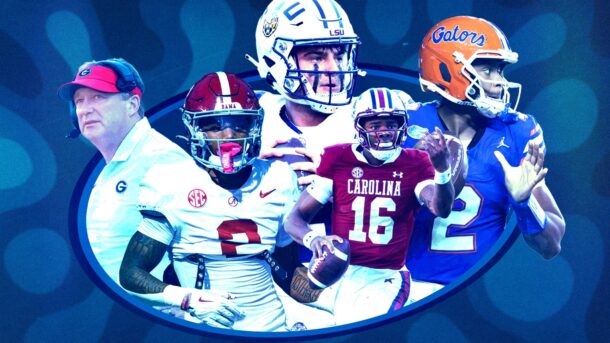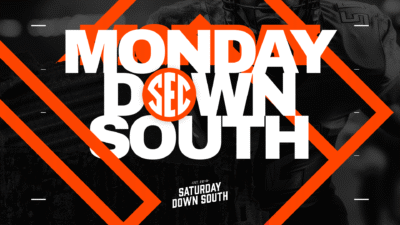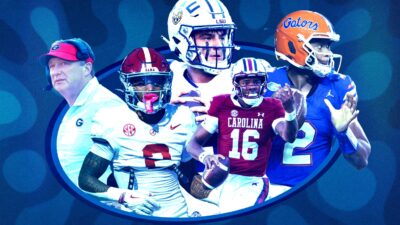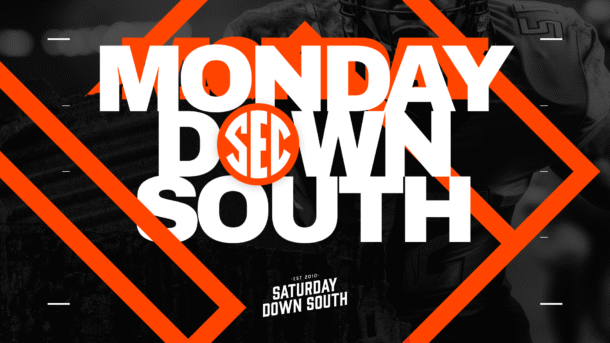
Monday Down South: Diego Pavia is making his Heisman case. Can he bring Vandy along for the ride?
By Matt Hinton
Published:
Takeaways, trends and technicalities from Week 11 in the SEC.
Diego for Heisman (for real)
It’s about that time of year for the making and breaking of Heisman campaigns to commence in earnest, and one by one, the barriers to a legitimate, non-ironic run by Diego Pavia continue to fall. The few that remain are looking flimsier by the week.
Let’s make the case. Why not? What doubts can you still express about Pavia at this point that didn’t also apply to another quarterback who won or came close in the past, say, 15 years? What, he’s too short? Bryce Young, hello. He’s not a first-round prospect or a fixture in mock drafts? Neither were finalists Collin Klein (2012) and Max Duggan (2022), among others. His humble origins in the hinterlands? See also: Baker Mayfield, originally a walk-on; Stetson Bennett IV, a walk-on who also did a stint in the JUCO ranks; or 2024 finalist Cam Ward, who began his journeyman college career at an FCS school. He’s too old? Chris Weinke was 28 when he won the Heisman! At 24, Pavia is a year younger than Bennett when he made the trip to NYC in 2022, and only a few months older than Dillon Gabriel last year, when he (like Pavia) was also a 6th-year senior on his 3rd school. (Gabriel is another example of a sub-six-footer who was largely ignored by the scouts, as well.) He looks the part, in the sense that there’s not really any hard-and-fast rule for what a Heisman contender looks like.
He can certainly hold his own in the box score. Up until a couple weeks ago, I would have said pump the brakes over Pavia’s good-not-great stat profile, which was more of a study in efficiency than a showstopper at first glance. After a couple of prolific, career-best outings the past 2 weeks in comeback mode against 2 of the SEC’s best defenses, Texas and Auburn, maybe it’s time to stop the show, after all. On paper, Saturday’s back-and-forth, overtime win over Auburn was arguably Pavia’s best game yet, and his team needed it to be. After nearly erasing a 24-point hole against the Longhorns in Week 10, he rallied Vanderbilt from an early 2-touchdown deficit against the Tigers and kept trading blows until the Commodores were the last team standing. Pavia set career-highs for passing yards (377), rushing yards (112), and EPA (15.4); turned in his best ever passer rating (201.7) against an SEC opponent; and finished with his best rating in terms of Total QBR (95.7) since posting a 96.0 rating last year’s monumental upset over Alabama.
There was a general consensus at the time, which probably carried over well into this season, that that game represented Pavia’s “15 minutes of fame,” the peak of his career as an eccentric, charismatic overachiever who’d just maxed out his potential on the right Saturday. It has turned out to be more like a warning shot from a guy who was only just getting started.
Down the stretch, he’s ascending the FBS leaderboards: 6th nationally in Total QBR, 5th in EPA, 4th in passer rating, and 3rd in passing success rate, 2nd in overall PFF grade, tied for 2nd in total touchdowns, and No. 1 in total yards. Anybody else, and you’re wondering why he doesn’t have the best Heisman odds.
But then, impressive as the numbers are, they miss the point of what really makes Pavia a compelling candidate just as surely as fixating on how he projects to the next level. In his case, the stats are there mainly to demonstrate that he ticks the right boxes on his résumé, his reference check out. The actual case, the one that will get him over to New York if he does in fact get there, is much more to the point: Here’s the guy — the only guy, like, ever — who singlehandedly made Vanderbilt matter.
Singlehandedly might be an exaggeration, but no by much. A year ago, eking out bowl eligibility in Pavia’s first season on campus felt like a minor miracle that could not have happened without the Bama stunner. Two years ago, Clark Lea was hanging on to his job by the skin of his teeth with a 2-22 record in SEC play over his first 3 seasons. Now, the ‘Dores really do matter: With Saturday’s escape over the Tigers, they’re 8-2, matching its most regular-season wins since World War I. One more SEC win will match Vandy’s most ever in a season with 5, achieved just once in the modern era under then-coach James Franklin in 2012. (Prior to that, the last team that pulled it off was in 1935.) Two more, over Kentucky and Tennessee on the other side of an open date in Week 12, and they’ll almost certainly punch their ticket to the College Football Playoff, completing one of the most dramatic doormat-to-destiny cycles on record. And no one in the sport has any doubt who is responsible for making that a reality.
If Pavia tends to be compared to any previous Heisman winner, of course, it’s his spirit guide, Johny Manziel, whom he emulates to whatever extent his not-quite-Manzielian athleticism allows. Pavia is less improvisational, by necessity, but you can see flashes of the same spark on occasion. In terms of what he means to his team and program, though, the more apt comparison might be to the guy who it the year before Manziel: Robert Griffin III. When RG3 arrived at Baylor in 2008, the Bears were the Vandy of the Big 12, a private school reduced to perennial laughingstock in the standings and in their national reputation, to the extent they had one. Three years later, they were in a bowl game for the first time in more than a decade; a year after that, Griffin won the Heisman in what was then only the 2nd 10-win season in school history. From there, it was on to national relevance and major bowl games, and they have never returned to the basement.
Pavia’s game might not resemble Griffin’s, but his value proposition to his team clearly does. His place on ballots and in history is still up for debate until we see how the story ends over the last 2 games, and possibly beyond. For Pavia, seriously contending for the Heisman and finishing off Vandy’s unlikely run with a pair of CFP-clinching wins might be one and the same; achieving one requires achieving the other. That’s true to some extent for every face-of-the-program quarterback. But few faces have become so inseparable from the program, so quickly. So goes Diego, so go the ‘Dores. If he’s going all the way, he’s going to have to take them all along for the ride.
Dude of the Week: Auburn WR Cam Coleman
For the record, Coleman turned in his best stat line as a Tiger against Vanderbilt, finishing with career-highs for receptions (10) and receiving yards (143) in (fittingly) a losing effort. In the grand scheme of things, the numbers are footnotes. The score is a footnote. The only thing anyone is going to remember about Saturday — or, frankly, the rest of Coleman’s frustrating Auburn career — is how they felt watching one of the truly unique talents of his era defying gravity right before their eyes.
Coleman has made so many impossible plays this year, you can hardly blame QB Ashton Daniels for being determined to throw in his direction on the decisive 2-point conversion in overtime despite 2 Vandy defenders explicitly assigned to Coleman Patrol in coverage. Daniels’ only regret was sailing the ball too high to give his man a chance.
Just give him a chance, the resigned slogan of Coleman’s sophomore campaign. Plenty of great college wideouts have been cursed with mediocre quarterbacks. (Calvin Johnson, hello.) These days, though, being universally acclaimed as America’s Best Player On a Bad Team as an underclassman is a blessing and a curse: One way or another, Coleman is set to make bank in 2026 on a team that, ideally, does not need him to make multiple epic video-game-glitch catches on a weekly basis just to keep it close. Whether Auburn still has a chance to be that team is TBD. But if the next head coach isn’t willing to do whatever it takes to keep him in the fold — up to and including soliciting Coleman’s input/approval in pursuit of a new starting QB — he’ll be well within his rights to find one who is.
Dud of the Week: LSU QB Garrett Nussmeier
I’m groping for the right word for Nussmeier’s performance against Alabama, and keep coming back to “inert” — dormant; not being in a state of use, activity, or employment.
I mean, he was out there. He was busily engaged in quarterback stuff, or appeared to be. On paper, he actually finished 18-for-21 passing, good for the best completion percentage of the season (85.7%) vs. an SEC defense. If you didn’t see it, that probably sounds impressive. If you did, you know it was anything but. It was more like watching a glitchy simulation unfold on an old video game that keeps dialing up the same busted screen play no matter how many times it gets snuffed out.
Of those 18 completions, 11 came on attempts behind the line of the scrimmage, per PFF, all but 1 of them screens. Nussmeier’s average depth of target on all attempts was a grim 2.9 yards, well below his already conservative ADOT of 7.3 yards for the season. He managed just 6.7 yards per completion. (Not per attempt, per completion.) He converted 1 3rd down, on the game’s opening series. His lone attempt of 20+ air yards fell incomplete. Alabama kept dropping 8 men into coverage, making little effort to bring pressure; he kept dutifully checking down. The 6 series he was in the game yielded 6 points.
Nussmeier’s final series of the night before being sent to the bench was a microcosm of his season. Trailing 17-3 at halftime, LSU opened the second half with its best drive of the night, moving the ball inside the Bama 10-yard line with the help of a facemask penalty against the Tide. It unraveled quickly. Facing 3rd-and-goal at the 8-yard line, the Tigers were flagged for delay of game. Before they could regroup, they were forced to call a timeout to avoid a second delay of game. Now facing 3rd-and-goal from the 13, with Alabama rushing just 3 and plenty of space to maneuver in the pocket, Nussmeier panicked, spun obliviously into a sack, and completed the sequence of purely self-inflicted errors that turned 1st-and-goal into a 44-yard field-goal attempt.
If that wasn’t literally the end of Nussmeier’s tenure in Baton Rouge, it certainly felt like it in spirit: The final rung on his career arc from gunslinging underclassman to tentative Heisman candidate to struggling scapegoat whose confidence is so shot he’s barely capable of throwing beyond the sticks. After getting visibly chewed out by interim head coach Frank Wilson, he spent the rest of the night on the bench, watching understudy Michael Van Buren Jr. operate the offense in fits and starts over the last quarter-and-a-half to little avail. Wilson gave no indication after the game who he plans to start for this weekend’s trip to Arkansas; regardless, LSU fans are mostly beyond caring, having collectively simmed to the end of the year, the arrival of a new head coach, the pursuit of a big-ticket transfer to fill the looming void behind center, and the merciful end of this cursed, dysfunctional campaign.
If he’s up for playing out the string, at least there won’t be any illusions that there’s any more to it than that. If not, then the question becomes how quickly the locals forget he was ever there.
CFP Realpolitik
It’s that time of year, when the fog begins to lift and the outlines of the postseason picture begin to come into view. Each week down the home stretch, CFP Realpolitik will size up the pecking order from a strictly practical perspective.
We were due for a dose of chaos, and very nearly got it Saturday in the Big Ten, where Oregon and Indiana narrowly escaped upset bids by Iowa and the zombie corpse of Penn State, respectively. The Ducks and Hoosiers both gave up go-ahead touchdowns late in the 4th quarter, and were both forced to execute do-or-die drives with their seasons on the line in hostile conditions. They both delivered, thereby preserving the status quo for yet another week. Eight teams now boast at least an 80% chance to make the 12-team CFP field, per ESPN’s Football Power Index: Indiana, Ohio State, Texas A&M, Alabama, Georgia, Oregon, Ole Miss, and Texas Tech. (Welcome to the Green Zone, Red Raiders.) Of course, we track the Playoff odds, too.
Barring an insane turn of events, the Hoosiers, Buckeyes and Aggies are mortal locks, and Alabama and Georgia can all but reserve their tickets this weekend with home wins over Texas and Oklahoma.
The rest of the field? Choose your own adventure. After the top 8, no other team clears 50%, including the best bet among the remaining at-large candidates, Notre Dame.
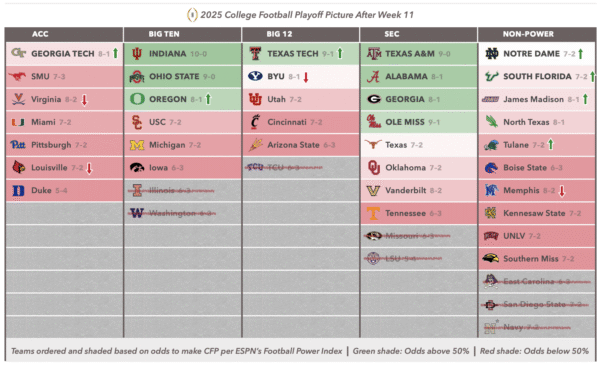
Notre Dame is not inevitable. First of all, the Irish have a non-trivial road test this weekend at Pittsburgh, which has won 5 in a row since promoting true freshman Mason Heintschel to starting quarterback. But for the sake of argument, let’s go ahead and project a 10-2 finish. That will probably get them in. To assure it, though, they still need some help — specifically in the SEC, where Texas, Oklahoma, and Vanderbilt can all still finish 10-2 as well, and with better hypothetical résumés than Notre Dame’s if they do. Given the remaining hurdles for all 3 of those teams, however, that is not exactly a likely scenario. (The Longhorns and Sooners are both clear road underdogs this weekend in Athens and Tuscaloosa; Texas, of course, also closes with Texas A&M in Austin. Meanwhile, Vandy will be an underdog at Tennessee.) But it is certainly within the realm of possibility.
If it’s Texas or Oklahoma in that equation, they will jump the Irish in line, no questions asked. In the significantly more likely case that it’s the Commodores, brace yourself for a forensic accounting of their strength of schedule vs. Notre Dame’s at every available opportunity in the week leading up to selection Sunday. No algorithm can predict how the committee would decide that debate, and I’d advise being wary of anyone who sounds too certain about the politics at play, too — in either direction.
Is the Big 12 a 2-bid league? The other question mark to consider re: Notre Dame is how the committee would weigh the 10-2 Irish against an 11-2 BYU or Texas Tech outfit coming off a competitive loss in the Big 12 Championship Game. (Recall SMU last year, which was not punished for its last-second loss in the ACC Championship Game.) Obviously, after Saturday’s 29-7 beatdown of BYU in Lubbock, the Red Raiders look like the class of the conference and clear-cut favorites to secure the league’s auto bid; at this point, a loss in either of their last 2 games against UCF or West Virginia or in the title game would be a significant upset. The Cougars, on the other hand, still have a couple of hurdles to clear against TCU and Cincinnati just to force a rematch. If either or both teams make it to Arlington at 11-1, though, and puts up a respectable fight in a losing effort while the Fighting Irish are watching from home, they will not go quietly.
Is Oregon on the bubble? The Ducks control their Playoff fate, assuming they win out to finish 11-1. No doubt about that. Relative to the other teams in the Green Zone, though, their margin for error is slim. Their biggest win to date, an overtime decision at Penn State in Week 5, has plummeted in value since the Nittany Lions fired their head coach in the middle of what is now a [checks notes] 6-game losing streak in conference play, wow. Their only outing against a current CFP contender, a 30-20 loss to Indiana in Eugene, effectively eliminated them from returning to the Big Ten Championship Game. Saturday’s water-logged escape at Iowa put a lot folks who were taking the Ducks for granted on alert. (They dropped a spot in the AP poll, falling behind Ole Miss following the Rebels’ dramatic 49-0 win over, uh, The Citadel.) None of their remaining dates against Minnesota, USC and Washington are slam dunks, but — like Iowa — don’t necessarily move the needle as notable wins, either. Of all the teams sitting on the right side of the divide right now, Oregon may be the one that can least afford to slip up.
The ACC: Don’t ask. Last week I put the de facto ACC frontrunner, Virginia, on fraud alert. The Cavaliers responded by losing at home to Wake Forest, 16-9, in a game featuring zero offensive touchdowns. (The decisive margin for the Demon Deacons came on a punt return.) But if you thought that was the last you’d heard of them, think again.
Look, somebody has to win this league. The best bet, right now, is 8-1 Georgia Tech; the Jackets are both the highest-ranked ACC team and the only team in the 5-way logjam at the top of the conference standings that actually controls its fate. But you could make a case for any of the other 4 — even Duke, which just fell to 1-3 in nonconference play in a 37-34 loss at UConn but still has a viable ACC Championship Game path. And you can’t completely rule out Louisville or Miami with 2 losses, either.
With the Cardinals’ loss to Cal, though, you almost certainly can rule out the possibility of any ACC team earning an at-large bid. Miami would love to run the table and put that statement to the test, especially given its head-to-head win over Notre Dame in the season-opener; if both teams finish 10-2, you can see the ‘Canes’ argument coming a mile away. But then, given the conspicuous gap between No. 10 Notre Dame and No. 18 Miami in the committee’s initial rankings, they’ve already anticipated that argument and signaled that they don’t find it particularly persuasive. The only other at-large possibility would be a very specific scenario in which Georgia Tech beats Pitt and Georgia to close the regular season, then loses the ACC title game to finish 11-2. Let’s hold off crossing that bridge until we come to it.
Notebook
1.) Marcel Reed continues to thrive on the road. Most young quarterbacks are just trying to survive in hostile territory, but Reed has been at his best: Texas A&M’s 4 road trips this season at Notre Dame, Arkansas, LSU and Missouri are his highest-rated games according to Total QBR, yielding at least 250 total yards and multiple touchdown passes in all 4. His rating in Saturday’s 38-17 win at Mizzou was a stellar 90.1 — the best by an opposing quarterback against the Tigers since the guy Reed replaced as QB1, Conner Weigman, posted a 94.1 in an even more lopsided win last year in College Station.
2.) You will never see a team more unprepared for a fake punt than Missouri, which was caught with its shoelaces tied together on A&M’s direct snap to upback Dalton Brooks in the 3rd quarter. At that point, the pendulum was beginning to tentatively swing in the Tigers’ direction following their first scoring drive of the game and an ensuing stop by the defense that figured to give the ball back to the offense with a chance to cut further into a 21-7 deficit. Instead, Brooks was off like a dog who’s just stolen a steak off the patio table before Mizzou had even begun to give chase.
When it’s that wide open, does it even qualify as a gamble? The man had so much open field he could have planted crops, harvested them, and turned the operation over to corporate management before encountering a Missouri player. By the time he reached the line of scrimmage, there wasn’t a Tiger within a 10-yard radius. By the time he crossed the 50, he was the only player on the dang screen:
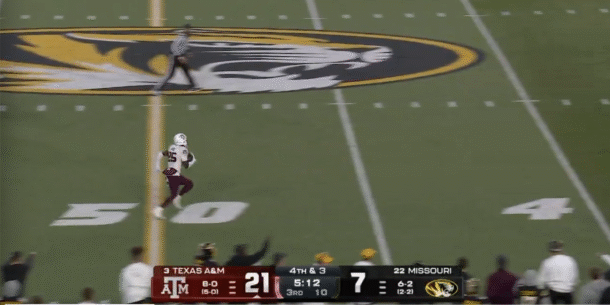
From there, the shocking part was that he somehow failed to score. The only remaining line of defense, punt returner Kevin Coleman Jr., didn’t appear until the camera panned to the Mizzou 30-yard line, where he finally managed to cut Brooks off more than 40 yards downfield from where he’d initially taken the snap; acing his geometry, Coleman managed to alter Brooks’ route long enough to pursue him into the waiting arms of a teammate inside the 20-yard line, “limiting” him to a 48-yard gain.
In fact, the Aggies were so stunned by their own success that the offense promptly earned a penalty for delay of game, knocking the ensuing series off-schedule before it had begun. They settled for a field goal, but still extended the margin to 3 scores, 24-7, effectively putting a game that Missouri was threatening to make an interesting on ice.
3.) Georgia played a vintage Georgia game, arguably for the first time all season against a real opponent. (Yes, Mississippi State counts, at least in Starkville; ask Tennessee and Texas, or the oddsmakers who set the points spread at a respectable 8.5 points.) I’ve been harping for weeks on how uninspired the Dawgs have looked even in victory, particularly their tendency to get off to a lethargic start. So credit where it’s due: Saturday’s 41-21 romp over State was exactly the kind of routine beatdown of an unranked underdog that they’d like to be able to get back to taking for granted. Yes, once again, the defense spotted the opposing offense a touchdown to open the game, a pattern I’m beginning to think of as akin to a batter in baseball habitually taking the first strike. After that, Georgia proceeded to score 38 straight points in a game that, for once, was not nearly as close as the final score. UGA outgained Mississippi State by 245 yards (including garbage time); spread touches among a dozen different players on offense; and leaned on a finally healthy o-line to open up the kind of gaping running lanes for sophomore RB “Shoeless” Nate Frazier that Bulldogs’ running backs have not enjoyed in a while.
Per PFF, 108 of Frazier’s 181 rushing yards for the game came before contact, an average of 9.0 yards per carry. As a team, 303 rushing yards represented Georgia’s biggest number on the ground vs. an SEC opponent since a 316-yard outing at Missouri in December 2020.
4.) The silver lining for Mississippi State was the emergence of freshman QB Kamario Taylor, who scored all 3 of the Bulldogs’ touchdowns as a rusher and generally looked ready to take the reins from 6th-year vet Blake Shapen. The gem of Jeff Lebby‘s first full recruiting class, the 6-4, 230-pound Taylor is huge, mobile, and plainly the future for a program that has not had much to look forward to the past few years. Prior to Saturday, he’d been primarily limited to a short-yardage role. He saw his first extended action in Week 10, accounting for 2 touchdowns in against Arkansas while Shapen was being checked for a concussion; if you’d polled Bulldogs fans at the end of the 3rd quarter of that game, I guarantee the response would have been overwhelmingly “leave the kid in.” Lebby thought otherwise, reinserting Shapen instead to finish off a come-from-behind, 38-35 win that snapped the Dogs’ 16-game conference losing streak.
Against an actual defense on Saturday, Shapen’s ceiling was all too obvious. In his 37th career start, he did nothing to threaten Georgia downfield or as a runner, and was altogether juiceless after hitting his marks on the scripted opening series. He went down hard in the 3rd quarter and this time didn’t return. With the game out of hand, Taylor came on to cheers from the home crowd, promptly led a 75-yard touchdown drive, and went on to account for Mississippi State’s longest run (23 yards) and pass of the afternoon, a 57-yard heave to Brenen Thompson that set up another late touchdown. Now, as a rule, most of what happens in garbage time is just that: Garbage. But when both your banged-up, 24-year-old journeyman and your prized recruit show you who they are on the same afternoon against one of the league’s standard bearers, maybe it’s time to take the hint.
And if all you’re concerned about is who gives you the best chance to win the Egg Bowl, well, somebody ask Lane Kiffin which guy worries him more. I bet he’ll tell the truth.
5.) LSU’s self-inflicted wounds on offense didn’t end with Garrett Nussmeier’s exit. On his first series in relief, backup Michael Van Buren Jr. scrambled for an apparent drive-extending first down on 3rd-and-10, only to have the spot overturned on review due to Van Buren dropping his hips to begin his slide a half-yard short of the line to gain. Trailing 17-6, the Tigers lined up to go for it on 4th-and-inches near midfield … and promptly committed a false start, setting the offense back five yards and forcing a punt instead.
Even LSU’s idiots on the field were in no mood to put up a fight.
6.) A bad call went Auburn’s way! It didn’t matter in the end, but after spending the past 6 weeks complaining about the refs, the Tigers finally benefited from an officiating gaffe on Ashton Daniels’ 16-yard touchdown run at the end of the 3rd quarter, when the side judge ignored a blatant hold — a straight-up tackle, in fact — on the perimeter by Preston Howard (No. 15 below) that allowed Daniels to turn the corner.
Besides negating the touchdown, a penalty would have forced the Tigers into 3rd-and-long, likely forcing them to settle for a field goal.
Notably, Howard was also responsible for another long Daniels TD run in the first half being wiped out due to a holding penalty that was actually flagged. The first one was a little iffy, in my opinion, so maybe the 2nd one merely balanced the scales. Either way, as far as Auburn fans are concerned the zebras are going to be paying down their debt from the Oklahoma and Georgia games for years to come.
Moment of Zen of the Week
Matt Hinton, author of 'Monday Down South' and our resident QB guru, has previously written for Dr. Saturday, CBS and Grantland.
